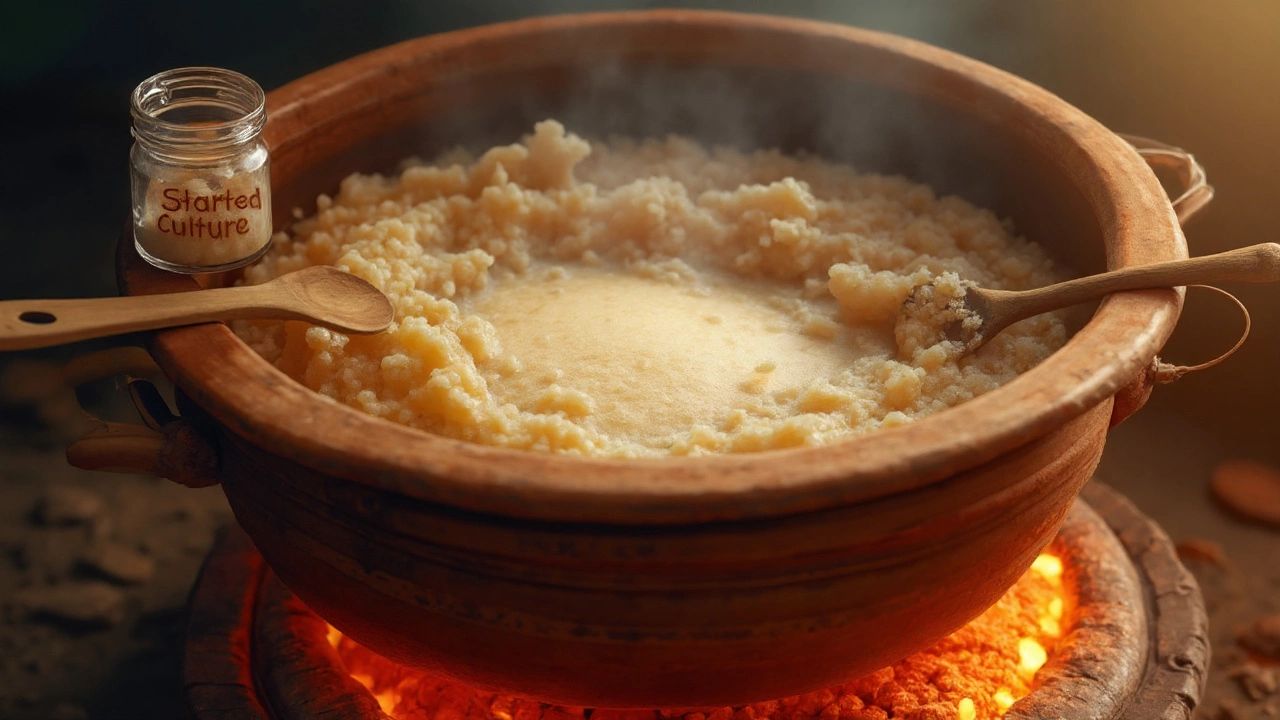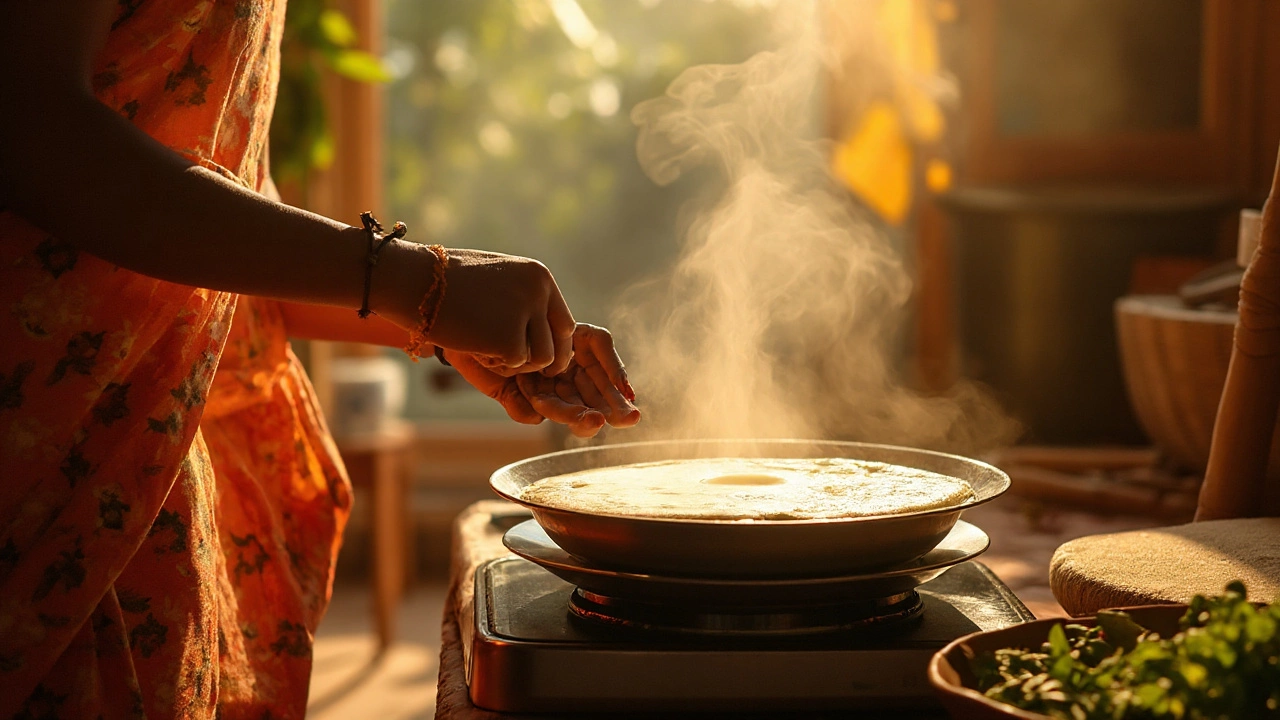Instant Dosa Fermentation Calculator
Dosa batter is a traditional South Indian mixture of soaked urad dal and rice that ferments to develop flavor and texture. The challenge for busy cooks is the long fermentation time-usually 8‑12 hours. This guide shows how to ferment dosa batter immediately using heat, starter cultures, and simple chemistry, while preserving the authentic taste that makes dosas so beloved.
Why Fermentation Matters
Fermentation is a natural process where lactic acid bacteria and wild yeasts break down carbohydrates, releasing acids and gases. In dosa batter, this yields a slightly sour aroma, airy texture, and improved digestibility. Skipping fermentation altogether can give a dense, flat crepe that lacks the signature crisp‑edge and fluffy interior.
Key Ingredients and Their Roles
- Urad dal (black gram) provides protein and the primary source of fermentable sugars.
- Rice (typically parboiled) contributes starch that gives the batter its body.
- Water - the medium for microbial activity; temperature governs the speed.
When any of these components are off‑ratio, the fermentation can stall, especially when you’re trying to speed things up.
Temperature: The Fast‑Forward Switch
Microbes hit their stride at 30‑40°C (86‑104°F). Raising the batter to this range can cut fermentation time from hours to minutes. Below are three reliable ways to create a warm environment without compromising safety:
- Pre‑heat a conventional oven to the lowest setting (around 45°C/110°F) and turn it off. Place the batter‑filled bowl inside and close the door for 15‑20 minutes.
- Use a microwave on the defrost setting for 30‑seconds, stir, then let sit covered for another 10 minutes.
- Put the batter in a thermos flask with hot water (no more than 50°C) for 10‑15 minutes; the insulated environment holds heat perfectly.
The key is to avoid boiling temperatures, which kill the beneficial microbes.
Starter Cultures: Borrowing Good Bacteria
If you’ve ever made idli or sourdough, you know a small amount of active culture can jump‑start a new batch. Here are two pantry‑friendly starters:
- Yogurt (plain, unsweetened). Stir in 2tablespoons per cup of batter; its live cultures act like a probiotic booster.
- Leftover fermented dosa or idli batter (a spoonful per cup). This is the most authentic shortcut, as the microbes are already adapted to the rice‑dal mix.
After adding a starter, keep the batter warm for 5‑10 minutes; you’ll see tiny bubbles forming-signs of active fermentation.

Chemical Leavening: When Biology Takes a Back Seat
For truly instant results, a pinch of alkali can mimic the airiness that microbes provide. Two common options:
- Baking soda - add ¼teaspoon per cup of batter, then a splash of lemon juice or vinegar to activate CO₂ production.
- Fresh lemon juice - 1teaspoon per cup, combined with a pinch of baking soda, creates a quick fizz.
These methods don’t develop the deep sour flavor of true fermentation, but they give a light, airy batter ready in under 5 minutes.
Comparison of Immediate Fermentation Methods
| Method | Time Required | Taste Profile | Texture | Nutrient Impact |
|---|---|---|---|---|
| Natural overnight fermentation | 8‑12hrs | Slightly sour, complex | Fluffy interior, crisp edge | Highest (pre‑biotic growth) |
| Warm‑environment shortcut | 15‑20mins | Mild tang | Good rise, decent crisp | Good (microbes stay active) |
| Yogurt starter | 5‑10mins | Gentle dairy note | Very airy | High (additional probiotics) |
| Chemical leavening (baking soda + lemon) | 2‑5mins | Neutral, no sourness | Light, slightly grainy | Neutral (no microbial activity) |
Step‑by‑Step: Ferment Dosa Batter Immediately
- Soak 1cup urad dal and 3cups rice separately for 4‑6hours. Drain.
- Blend each batch to a smooth paste, adding water as needed. Mix the two pastes together.
- The batter should be pour‑able, about 1cm thick.
- Stir in 2tablespoons plain yogurt (or a spoonful leftover fermented batter) as a starter.
- Cover the bowl with a clean kitchen cloth. Place it in a pre‑warmed oven (45°C) for 10minutes.
- After 10minutes, check for tiny bubbles on the surface. If present, the batter is ready; if not, add another 5minutes.
- For a pure chemical boost, skip the yogurt and add ¼teaspoon baking soda plus 1teaspoon lemon juice. Let sit for 2‑3minutes.
- Heat a non‑stick skillet over medium‑high heat, drizzle a few drops of oil, and pour a ladleful of batter. Spread thin, cook 1‑2minutes until edges lift, then flip if you like.
- Serve hot with coconut chutney, sambar, or your favorite fillings.
This recipe yields a batter ready in under 30minutes, perfect for a rushed weekday breakfast.
Troubleshooting Common Issues
- No bubbles after warming: The batter may be too cold or the starter inactive. Raise the temperature slightly or add a fresh spoonful of yogurt.
- Too thick: Thin with water 1‑2tablespoons at a time; consistency should be like pancake batter.
- Sour taste is missing: Chemical leavening won’t provide tang. Use a starter or let the batter sit a few extra minutes in the warm spot.
- Grainy texture after baking soda: Ensure the batter is well‑whisked to dissolve the alkali completely.
Related Concepts and Next Steps
Understanding immediate fermentation opens doors to other quick‑fix recipes:
- Idli batter: Same ingredients, but steam‑cooked. Use the same warm‑starter method for fluffy idlis.
- Sourdough starter: The principle of borrowing live cultures applies across cuisines.
- Probiotic drinks: Yogurt or kefir can be added to batter for extra health benefits.
After mastering instant dosa, explore variations like spinach dosa, banana‑flower dosa, or gluten‑free chickpea dosas using the same quick‑ferment techniques.

Frequently Asked Questions
Can I use instant rice instead of parboiled rice?
Yes, but instant rice has a higher gelatinization rate, which can make the batter overly sticky. Use a 1:1 ratio and add a little extra water to keep the consistency pour‑able.
Is it safe to ferment batter at 45°C for a long time?
Short bursts (10‑20minutes) are fine and actually boost microbial activity. Prolonged exposure can kill the good bacteria, so keep the warm period brief.
What’s the difference between using yogurt and a leftover batter as a starter?
Yogurt adds dairy‑derived probiotics, giving a slightly tangy note. Leftover batter carries the exact microbial community suited to rice‑dal, often resulting in a more authentic flavor.
Can I store the instantly fermented batter for later use?
Yes. Refrigerate in an airtight container for up to 48hours. The batter may become slightly more sour over time, which many people enjoy.
Do chemical leaveners affect the nutritional value of dosas?
They don’t add or remove nutrients, but they skip the probiotic boost you get from natural fermentation. If you’re after the health benefits of live cultures, stick with a starter or warm‑environment method.
Why does my batter become too thick after adding baking soda?
Baking soda reacts with acids to produce CO₂, which can cause the batter to foam and thicken quickly. Add a splash of water after the reaction to loosen it back to a pour‑able consistency.
